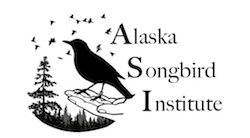Check out our video on why birdwatching is awesome, and how to get started! Then, see the map below for our favorite birding spots in the Fairbanks area.
Fairbanks Area Birding Spots:
Creamer’s Field Migratory Waterfowl Refuge: Creamer’s is a hotspot for birds during spring and fall migration as well as during the breeding season. If shorebirds come through Fairbanks during spring migration, this is one of the best places to see them. The front and back fields are good places to watch waterfowl, swans, cranes and geese. The trails are good for songbirds and forest raptors such as goshawk and sharp-shinned hawk. Tree swallows nest in the many nesting boxes around the front fields and trails, and our Creamer’s Field Migration Station is located along the Seasonal Wetland trail. (Follow link for info and maps.) Visitors are always welcome. Chat with our volunteers, come along and check some mist nets, and see a songbird getting banded. The seasonal pond on the way to is also a great birding spot, especially in spring. . A good tip is to wear break-up boots as the trails can get pretty mucky during spring break up.
Tanana Lakes Recreation Area: This site is particularly good for shorebirds in spring, but is also good for waterfowl and arctic terns. The trails are good for songbirds, including yellow-rumped warblers and ruby-crowned kinglets. Parking is located in the lot on the South Cushman side. There is a gate that is often locked at 6pm but you can still park in the lot and walk along the dikes to view the lakes and birds below. There’s a shooting range close by, so be prepared to hear guns.
Airport front ponds/East ramp float ponds: The airport front ponds and the float ponds are good for waterfowl, including grebes, scoters and loons. In addition, you can find shorebirds here in the spring—mostly “peeps” and lesser yellowlegs, but occasionally hudsonian godwits or long-billed curlews will make an appearance. Access to the airport front ponds is via the short-term parking lot; the first half-hour is free. Access to the east ramp float pond (where all the puddle jumpers take off) is via University Avenue South. You have to pass through a gate, but it will open as you approach with your car.
Peat Ponds: These ponds are located at the intersection of Murphy Dome and Goldstream Roads. They are particularly birdy during spring and fall migration, where you will find many waterfowl species, as well as grebes. Occasionally a belted kingfisher will show up. Shorebirds use the ponds on spring migration. Lesser yellowlegs nest in the area, so be prepared to hear their call all summer long. Bonaparte’s gulls nest around the perimeter of the ponds in the black spruce and are fun to watch as they defend their nests against other gulls. This is the only place in the interior to see nesting red-winged blackbirds. There are usually one or two pairs mixed in with the rusty blackbirds. This place is loaded with white-crowned sparrows and ruby-crowned kinglets.
Murphy Dome: Drive all the way to the end of Murphy Dome Road. Warning–the pavement ends at 8-mile, but the road continues to be driveable. Here you will find tundra habitat and associated bird species relatively close to Fairbanks. Park and wander around the trails. This is also a great spot to see (and hear!) large groups of migrating waterfowl and cranes streaming high overhead in fall.
Day trips from the Fairbanks area:
Delta Junction: Particularly good during spring migration—see agricultural fields loaded with geese, swans and other waterfowl. If you’re lucky, you can see sharp-tailed grouse lekking and short-eared owls along the fields. A trip to Clearwater Lake will get you Bald Eagles, geese, waterfowl and songbirds in the surrounding woods.
Eagle Summit: A 2-hr drive along the Steese Highway will get you in high tundra habitat where you will see a suite of birds not likely seen other places in the interior. The best time to go is in June. American Golden Plovers, Horned Larks, Wheatears, and Lapland Longspurs—all nest here. If you’re lucky, you might see Long-tailed Jaegers or even Surfbirds.
